Geography
France or the French Republic is a country located on the European continent. The nation has a population of approximately 62.6 million inhabitants spread over a territory that occupies 551 500 km².
France is among the richest and most developed countries in the world. In Europe, it ranks third among the continent’s economies, second only to Germany and the United Kingdom. Globally, it is the sixth economy, surpassed by the United States, Japan, Germany, the People’s Republic of China and the United Kingdom.
The capital, Paris, plays an important role in Europe, and is one of the most populous in the continent. In addition, it is considered a global city, that is, one of the most important in the world.
France, officially the French Republic, is a country located in western Europe . It is the third largest country on the European continent and one of the oldest in the world.
It is bathed by the Atlantic Ocean and the Mediterranean Sea. It is bordered by Germany, Andorra, Belgium, Spain , Italy, Luxembourg, Principality of Monaco and Switzerland.
General Information
- Capital: Paris
- Territorial extension: 549,190 km²
- Inhabitants: 64,395,345 inhabitants (2015 data)
- Climate: Mostly temperate
- Language: French
- Religion: Catholicism
- Currency: Euro
- Government System: Semi-presidential Democratic Republic
- President: Emmanuel Macron
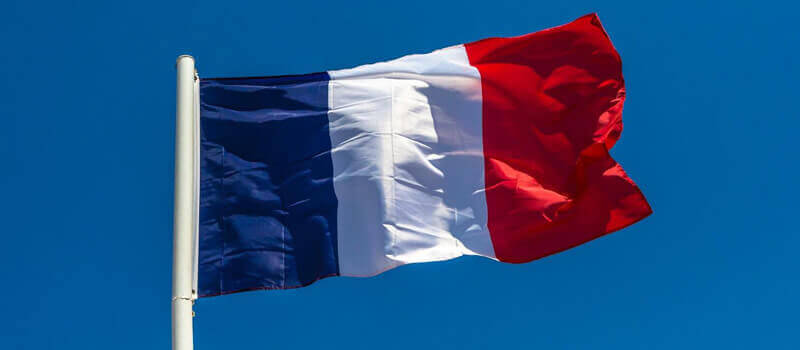
The tricolor flag is the national emblem of France. It consists of three bands in the colors blue, white and red, which are presented in a vertical direction in that order, from left to right.
White is the color of royalty, while blue and red are the colors of the revolution. Together, they have a sense of unity between people and monarchy.
History
In 1794, during the Convention period, the tricolor flag was adopted as an official flag.
Initially, the order of the colors of the French flag was red, white and blue. The legend says that it was the painter Jean-Louis David (1748-1825), official painter of Napoleon Bonaparte, who chose the order of the current colors: blue must always appear next to the mast.
With the return of Louis XVI, brother of Louis XIV, to the throne of France, the tricolor flag was replaced by the old Bourbon flag that was entirely white.
The blue, white and red flag would be recovered, precisely, in the July Revolution (1830), when the insurgents put it on the barricades while fighting against King Charles X.
However, even among Republicans, the flag was not unanimous.
On February 25, 1848, supporters of a socialist republic wanted to change the three colors by replacing it with an entirely red flag.
It was the poet Alphonse Lamartine (1790-1869) who convinced them that the tricolor pavilion, full of stories of fighting tyranny and war, also represented them.
France Flag Today
The Magnificent Letters of 1946 and 1958 (article 2) enshrined the blue, white and red flag as the national emblem of the Republic.
It must be present in all public buildings such as schools, embassies, city halls and barracks. In addition, it is performed in official, civil or military ceremonies.
When the Chief Executive, the President of the French Republic, speaks in public, the French flag must always be behind him.
Map
France is divided into 18 regions and 96 municipalities or departments.
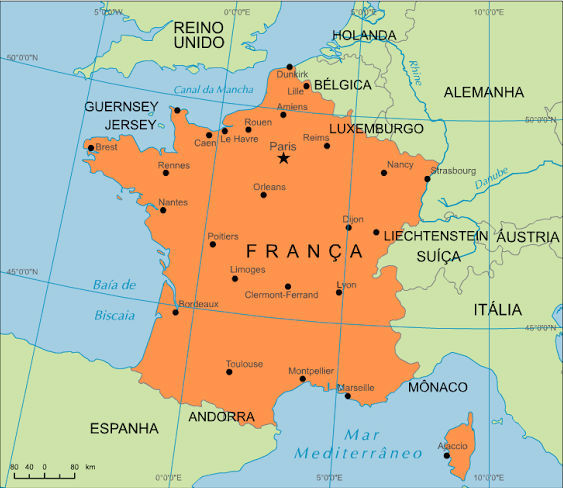
Before the move, in 2016, there were 22 metropolitan regions. Now there are 13:
| Metropolitan Regions | Capitals |
|---|---|
| Hautes de France | Lille |
| Auvergne-Rhône-Alpes | Lyon |
| Burgundy-Franche-Comté | Dijon |
| Brittany | Rennes |
| Center-Valley of Liberia | Orleans |
| Corsica | Ajaccion |
| Great East | Strasbourg |
| Île-de-France | Paris |
| Normandy | Roan |
| New-Aquitaine | Bourdeaux |
| Occitania | Toulouse |
| Liberia country | Nantes |
| Provence-Alpes-Côte d’Azur | Marseille |
Five of all regions in France are overseas regions:
- Guadeloupe
- French Guiana
- Martinique
- Meeting
- Mayotte
The capital Paris is the largest city in France. Lille, Lyon, Marseille and Toulouse are other important cities.
Hymn
The official anthem of France is called Marseillaise. It is originally a revolutionary song by Claude-Joseph Rouget de Lisle, captain of the French army, which was composed in 1792.
The purpose of the song was to encourage soldiers to fight for the country during the French Revolution , as shown in the initial sentence of the musical composition:
“Onward, children of the Fatherland,
The day of Glory has arrived.”
Culture and Tourism
Freedom, Equality and Fraternity (in French, Liberté, Egalité, Fraternité ) is the motto of the French revolution that has become the heritage of this country that has vast cultural wealth.
For this reason, France is highly sought after by tourists from all over the world, who number in the millions annually.
Museums, monuments, beaches are just some of its attractions. Paris, the city of light, is also known as the city of shopping.
The Notre Dame Cathedral in central Paris, is the biggest attraction of the country. Gothic in style, the construction started in 1163, taking almost 200 years to complete.
The cathedral is a masterpiece that houses a series of sculptures and paintings. In it, Napoleon Bonaparte was crowned emperor in 1804.
The Eiffel Tower , also in Paris, is a symbol of France that took two years to build, which happened in 1889.
Designed by Gustave Eiffel, it is 324 meters high and was made for the Universal Exhibition of 1889. Therefore, it should not be a lasting construction, and its demolition is expected after 20 years of exposure.
Anthem of France
The anthem of France is called “La Marseillaise”. It was initially created as a war song.
Language of France
The official language is French, although it has some other regional languages like Breton and Occitan.
Despite this, almost all French people speak at least 3 languages. Most speak French, English and at least another third language.
Currency of France
France’s currency is the euro, as well as in several European countries.
The French food is one of the most famous in the world, know the most traditional dishes and how to try.
French food: cheeses, wines and breads
When it comes to French food, what comes to your mind? Cheese and bread? Of course, without forgetting the different wines to accompany! How not to remember also the croissants, breads with chocolate, macaron, sweets, etc.
The smell when passing near a boulangerie (bakery)! Hmm .. delicious… Impossible to buy a warm baguette and not eat even a piece before arriving at home or at the hotel. There is no way to resist.
And the pâtisseries showcases with those gorgeous mouth-watering sweets? Very inviting right?
French food is one of the advantages of living in France . French cuisine is so rich that you can eat a different dish every day. The meal is sacred from France. A meal can take up to 2 hours, if you have all the steps. French food is taken very seriously by the French.
French food: the top 10 dishes
1. Le cassoulet
Created during the 100-year war, it is a very energy-rich dish made from white beans.
Some say that Cassoulet was the inspiration for our feijoada. Despite being a dish present practically throughout France, Toulouse and Carcassonne are the cities best known for this dish.
2. La blanquette de veau
Called a blanquette due to the white coating of its sauce, this dish is made by the veal’s breast or shoulder cooked in water with carrots, celery and onion to form a broth.
3. Les cuisses de grenouilles
Usually frog legs are eaten with garlic butter and parsley. It is a dish consumed since the 16th century by the French elite. Although this dish is also consumed outside France, France remains the largest consumer.
4. The croque-monsieur
It’s like our mixed-hot but more refined. According to them, the croque-monsieur appeared in 1910 in Paris in a brasserie on Boulevard des Capucines. It consists of loaf of bread, ham and cheese.
In addition, when a fried egg is placed on top, it becomes le croque-madame.
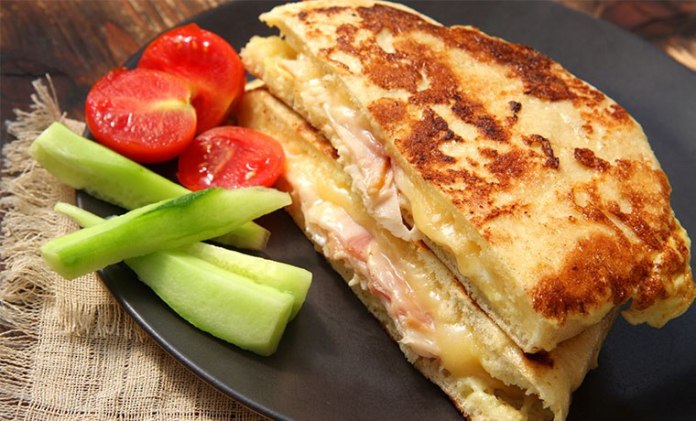
5. Le gratin dauphinois
They say that on July 12, 1788, the lieutenant general of Dauphine offered municipal officials in the village of Gap a dish that was hitherto unknown: the Dauphinoise potatoes. Cut into slices, the potatoes are roasted with garlic and cream or milk, releasing a deliciously melted flavor.
6) Le bœuf bourguignon
The two main ingredients of this dish are: Charolais meat and wine from the Côte de Nuits or Beaune vineyards.
It was one of the peasants’ favorite dishes on feast days. Slowly cooked over low heat, it is served with onion, garlic and bacon. It makes your mouth water just to remember.
The Greek food is not left behind when it comes to European delights. Check out the main ones.
7. Le pot-au-feu
It is a dish that requires long cooking of meat in a pan over low heat.
It usually consists of a long-cooked piece of meat, bone marrow from a tail of meat, vegetables and spices of all kinds.
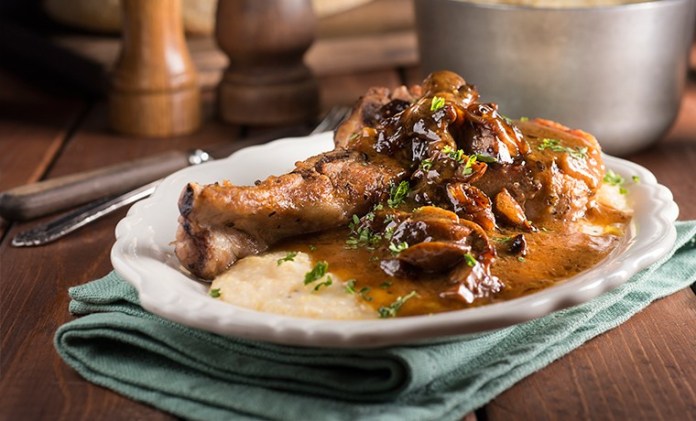
8. La quiche lorraine
Famous and present throughout France, you can eat Lorraine quiche as a starter or main course. In addition to being present in several bakeries. It is prepared based on pasta, eggs, cream and bacon.
In fact, in France, there are several types of quiche, although the Lorraine quiche is the most famous, be sure to try the leek quiche.
9. La Bouillabaisse
Typical Marseille dish, it was created in the 7th century. Its name in Occitan Provençale (a dialect spoken at that time in this region) means “to lower the boil”. It is actually a fish soup, garlic croutons and potatoes.
It is served in 2 stages: first the soup, then the fish. In addition, it is very well accompanied with rosé wine from Provence.
10. Le coq au vin
Dish reminiscent of one of the French symbols (the coq gaulois – cock). It is said that the first time it was served was when Julius Caesar decided to cook a rooster sent by a Gallic leader along with wine. However, it is difficult to know if this version is true.
In fact, several regions such as Auvergne, Alsace, Burgundy and Champagne dispute the creation of this dish.
Le coq au vin is made of rooster cooked with vegetables and red wine. It is usually accompanied by pasta or steamed potatoes.
See also other French symbols like your flag and the anthem of France .
French cuisine is very rich and there are many other dishes such as onion soup, raclette, etc.
Health and education
It is important to be aware that public health in France is paid for. That is, you pay for the consultation and then the government reimburses you for most of the expenses. The reimbursement varies between 70% and 100% of the expenses.
Education here is free. And from September 2018 it will be mandatory for children from 3 years old.
That is, even if the child is a foreigner, regardless of whether the parents are legal or not in France, the child will have a place at school.
Schools are chosen according to the parents’ address. They are usually all day, with the exception of Wednesday, which usually have classes only in the morning. In addition, children have lunch at schools.
The teaching is of quality. In addition to subjects such as mathematics, history and geography, children have physical education, music, and 3 languages (from the age of 11), among others.
Transportation
French roads are great. The only problem is its many tolls. However, it is not necessary to have a car to move between cities or even within the city.
Most cities have an excellent public transport network as well as rental transport options such as electric cars, motorbikes, scooters and bicycles available for rent.
Cost of living
The cost of living in France is totally linked to your lifestyle and also to the city that you chose to live / stroll. Special attention to Paris, the most expensive city in France.
France’s minimum wage in 2020 is € 1,539.40 gross. Depending on your lifestyle, it is a possible salary to live in any city in France (except Paris).
Job
France is on the rise, with several job opportunities available . It is not necessary to speak French to get a job here, but if you speak French, it will be easier to get a job.
Do you think about coming to work in France? So be sure to read the article on job sites in France .
Travels
It is very easy to travel within France as well as to European countries.
France has an excellent rail network, with several train schedule options. In addition, several bus companies connect the most diverse French and European cities.
Traveling here has never been easier and cheaper!
Cities
France is a country that despite being much smaller than Brazil has cities with very different lifestyles.
Do you like a lot of movement? So you need to know Paris. Is it quieter but you don’t like a very small town? So good options are Lyon and Toulouse, for example.
If you need to live close to the sea but you don’t want a small city, you must visit Nice and Marseille.
Attractions
France has several tourist spots to visit. The most famous are in Paris and the surrounding area. So be sure to check out our guide on what to do in Cidade Luz .
The main tourist attractions in France are:
1. Eiffel Tower
2. Arc de Triomphe
3. Louvre Museum
4. Notre Dame Cathedral
5. Sacre Coeur Church
6. Palace of Versailles
7. Mont Saint-Michel
8. Lavender Fields
9. Loire Valley and its castles as the Chambord Castle
10. Gorges de Verdon
11. Southern beaches such as Nice and Marseille
12. Cliffs of Étretat
13. Carcassonne
14. Port of Honfleur
15. Annecy
Eiffel Tower

History
The Eiffel Tower was built for the “Universal Exhibition” ( Exposition Universelle ) event that took place in 1889 in Paris. The event was held on the centenary of the French Revolution (1789).
Through a competition developed by the French government, several engineers and architects presented their projects.
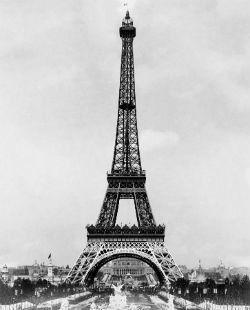
The Eiffel Tower is a large tower that is located on the Champs de Mars ( Champ de Mars ) in Paris, France.
The monument has become an icon of the city, the country and Europe, which receives millions of visitors every year.
Finally, it was designed by the French engineer Gustave Eiffel (1832-1927) and its construction took about two years.
In Art Nouveau style , it was made in iron and opened on March 31, 1889. The “Universal Exhibition” had approximately 2 million visitors.
It is curious to note that the initial idea was to be dismantled after the end of the event. However, it remains in place today.
On the first level of the tower you can see a large part of the city. Inside, we can find shops, toilets, restaurant, cafes, etc.
Trivia about the Eiffel Tower
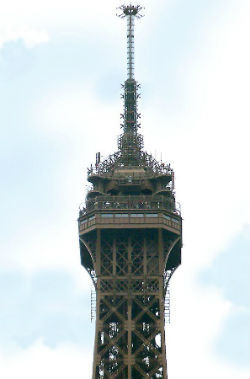
- The Eiffel Tower is 324 meters high and has three levels.
- The Eiffel Tower is the tallest structure in Paris and the second in France. It is behind the 343-meter Millau viaduct.
- Until 1930, the Eiffel Tower was the tallest structure in the world.
- It is the most visited paid monument in the world.
- In summer, the tower is about 15 centimeters higher due to the expansion of the iron.
- Its structure features more than 15 thousand pieces of iron and 2.5 million screws. Its weight exceeds 10 thousand tons.
- When it opened, visitors climbed 1,700 steps to the top of the tower. Nowadays, it has an elevator.
- Gustave Eiffel, the engineer responsible for building the tower, also participated in the Statue of Liberty project in New York, United States, and the Maria Pia Bridge, in Porto, Portugal.
- There are several replicas of the Eiffel Tower around the world: Las Vegas (United States), Sucre (Bolivia), Tokyo (Japan), Hangshou (China), Urals (Russia), Calcutta (India), Naqura (Lebanon).
The Louvre Museum in Paris receives millions of visitors each year. It is undoubtedly one of the most visited museums in the world.
One of the most famous works on display in this art gallery, which houses more than 35,000 works, is the Mona Lisa, by Leonardo da Vinci.
Among the points of interest, the Arc de Triomphe offers a privileged view, from where you can see the whole of Paris. It is a work of architecture dating from 1806. The monument is a tribute to the Imperial Army and was built by order of Napoleon Bonaparte.
With regard to gastronomy , cheese is a symbol. It is a true passion of the French.
In the country, there are hundreds of varieties of cheese. To accompany it, there is wine, as France is one of the largest producers of the drink in the world.
The baguette, famous French bread, can be found in several locations.
Famous Personalities and Celebrities :
- Joan of Arc (1412-1431)
- King Louis XIV (1638-1715)
- Voltaire (1694-1778)
- Marie Antoinette (1755-1793)
- Napoleon Bonaparte (1769-1821)
- Victor Hugo (1802-1885)
- Marie Curie (1867-1934)
- Alfred Dreyfus (1859-1935)
- Charles de Gaulle (1890-1970)
- Jean Paul Sartre (1905-1980)
- Claude Monet (1840-1926)
- Gustave Eiffel (1832 – 1922)
- Claude Debussy (1862 – 1918)
- Antoine de Saint-Exupery (1900-1944)
- Coco Chanel (1883 – 1971)
Economy
The French economy is among the top five in the world. France is among the three most industrialized countries in Europe.
The country, which is the largest agricultural producer in the European Union, mainly produces meat, corn, wheat and wine.
The largest producer of nuclear energy in the world is France, which also stands out in the automotive and electronics industry.
Effect of covid-19 on France Economy.
France’s economy succumbed to the effects of the pandemic and GDP fell 5.3% in the first three months of the year. The drop is similar to that recorded in the second quarter of 1968, in which France was paralyzed by numerous strikes
Unsurprisingly, the French economy entered a recession. After a 0.1% drop in the last quarter of 2019, Gross Domestic Product (GDP) fell 5.3% in the first three months of 2020. The data released this Friday by the National Statistics Institute (INSEE) report of a downward revision compared to the previous estimate of a decline in activity of – 5.8%.
“This unusually strong situation can be explained by the replacement of certain estimates and extrapolations for the month of March, which are very affected by the containment measures” adopted since March 17, explains INSEE in a statement, quoted by the agency France Press. Given the current difficulties in measuring the extent of the economic and social reflexes caused by the pandemic, economists admit as probable that the figures released today will be revised again.
The drop in GDP in the first three months of 2020 is the same as in the second quarter of 1968, marked by the strong strikes in May in France.
The two-month shutdown of the economy due to the pandemic caused a brutal and violent halt in the activity of many sectors. Analysts believe that the multiplication of government announcements of measures to combat the crisis during confinement may help to limit damage in the short term. On the other hand, INSEE economists fear that the repercussions of the Covid-19 crisis will worsen during the second quarter.
